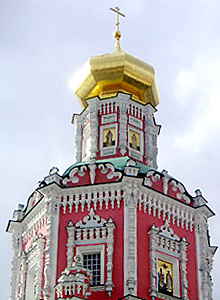 |
 Legend has it that this Kitai Gorod monastery was established by Grand Duke Daniil, first Prince of Moscow, in the late 13th Century, making it the oldest in the city. The first hegumen (Orthodox Abbot) of the monastery is recorded as being Stefan, the older brother of St. Sergei of Radonezh, the highly venerated 14th Century saint who founded the Trinity Monastey in Sergiev Posad.
Legend has it that this Kitai Gorod monastery was established by Grand Duke Daniil, first Prince of Moscow, in the late 13th Century, making it the oldest in the city. The first hegumen (Orthodox Abbot) of the monastery is recorded as being Stefan, the older brother of St. Sergei of Radonezh, the highly venerated 14th Century saint who founded the Trinity Monastey in Sergiev Posad.
The first stone church was built on the site in 1342, and the monastery rapidly became one of the most important in Moscow, patronized by the Grand Dukes and later the Tsars. Ivan the Terrible was particularly generous to the institution, presenting the monks with money, lands and special taxation rights. For a short while in the middle of the 17th Century, the monastery housed the school of the Greek Likhud brothers, who went on to found the celebrated Slavo-Greco-Latin Academy in the neighbouring Zaikonospasskiy Monastery. The monastery suffered its fair share of disasters, too - sacked by the White Horde in 1382, and damaged by fire at least four times in its long history. Even before the Revolution, the monastery had been used for commercial purposes, with the monks renting out parts of the territory to haberdashers as early as the 18th Century, and establishing a dokhodniy dom - a kind of early business centre - within the cloisters in 1909. When the Bolsheviks came to power, the monastery was used first as a campus for the Mining Academy, and later as a metal works. In the 1950's, many of the monastery's buildings were destroyed to make way for an administrative block.
Restoration work began in the 1980's and, after the fall of the Soviet Union, the monastery was officially returned to the Church. Restoration was speedy and well-funded, and the buildings that can be seen today include the striking Moscow Baroque Epiphany Cathedral, consecrated in 1696, and monks' cells and the abbot's chambers dating from the same period. The 1739 bell tower has also survived.
|
 |

 Legend has it that this Kitai Gorod monastery was established by Grand Duke Daniil, first Prince of Moscow, in the late 13th Century, making it the oldest in the city. The first hegumen (Orthodox Abbot) of the monastery is recorded as being Stefan, the older brother of St. Sergei of Radonezh, the highly venerated 14th Century saint who founded the Trinity Monastey in Sergiev Posad.
Legend has it that this Kitai Gorod monastery was established by Grand Duke Daniil, first Prince of Moscow, in the late 13th Century, making it the oldest in the city. The first hegumen (Orthodox Abbot) of the monastery is recorded as being Stefan, the older brother of St. Sergei of Radonezh, the highly venerated 14th Century saint who founded the Trinity Monastey in Sergiev Posad.